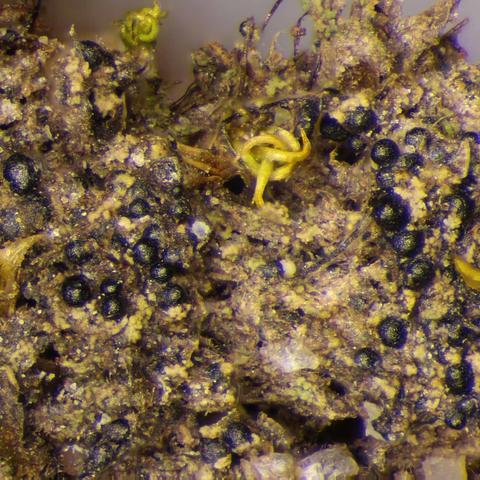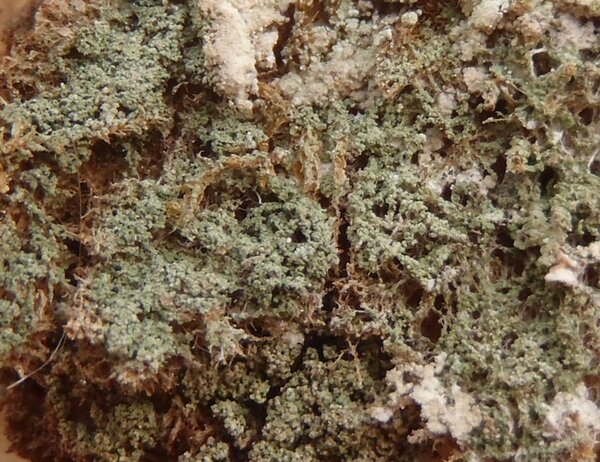Agonimia globulifera M. Brand & Diederich
in Sérusiaux & al., Lejeunia, 162: 8, 1999.
Synonyms:
Distribution: N - Piem (Ravera & al. 2021). C - Laz (Sérusiaux & al. 1999). S - Bas (Hafellner 2014b)
Description: Thallus crustose, episubstratic, minutely granulose, the granules (goniocysts) 0.02-0.06 mm wide, lobulate-digitate, often aggregated into 0.07-0.24 μm wide, black, glossy, sterile globules, the cortical cells colourless, minutely papillate. Perithecia rare, black, subglobose to pyriform, superficial or partly immersed, 0.25-0.45(-0.6) μm across, without involucrellum. Exciple 3-layered, with an outer layer of rounded, heavily pigmented cells, a median layer of similar, but unpigmented cells, and an inner layer of elongated, colourless cells; hamathecium of periphyses and periphysoids, interascal filaments absent; hymenial gel hemiamyloid. Asci 8-spored, clavate, thin-walled, fissitunicate with a very thin exoascus, surrounded by a hemiamyloid gel. Ascospores strongly muriform, with (22-)40-55 cells visible in optical view, hyaline, ellipsoid, (32-)41–54 x 15–26 μm. Photobiont chlorococcoid. Spot tests: thallus K-, C-, KC-, P-, UV-. Chemistry: without lichen substances.Note: a species growing on soil, plant debris and mosses in dry calcareous grasslands, mostly below the subalpine belt; perhaps more widespread in Italy. The sterile glossy black globules are diagnostic, while ascomata are rare and dull black.
Growth form: Crustose
Substrata: soil, terricolous mosses, and plant debris
Photobiont: green algae other than Trentepohlia
Reproductive strategy: mainly sexual
Commonnes-rarity: (info)
Alpine belt: absent
Subalpine belt: absent
Oromediterranean belt: absent
Montane belt: very rare
Submediterranean belt: absent
Padanian area: absent
Humid submediterranean belt: very rare
Humid mediterranean belt: absent
Dry mediterranean belt: absent

Predictive model
Growth form: Crustose
Substrata: soil, terricolous mosses, and plant debris
Photobiont: green algae other than Trentepohlia
Reproductive strategy: mainly sexual
Commonnes-rarity: (info)
Alpine belt: absent
Subalpine belt: absent
Oromediterranean belt: absent
Montane belt: very rare
Submediterranean belt: absent
Padanian area: absent
Humid submediterranean belt: very rare
Humid mediterranean belt: absent
Dry mediterranean belt: absent

Predictive model
 Index Fungorum
Index Fungorum
 GBIF
GBIF




